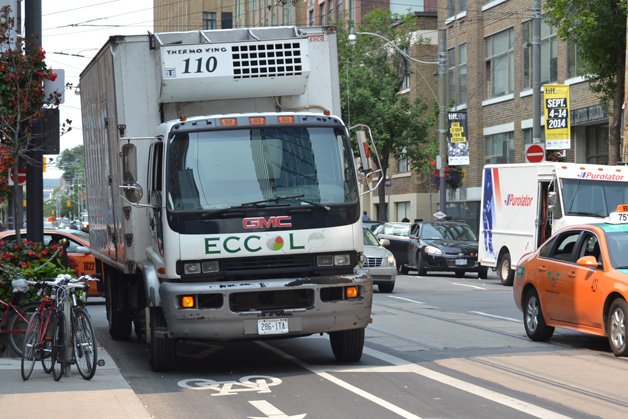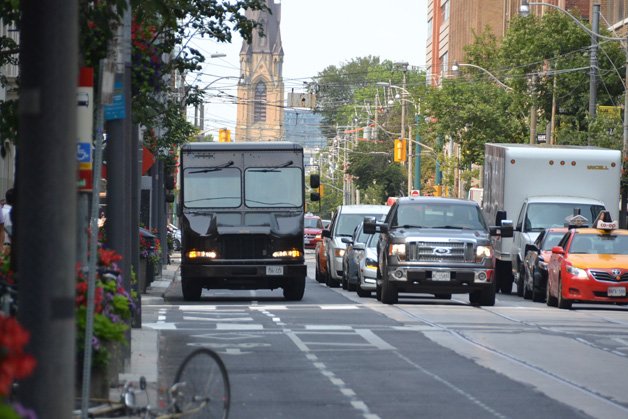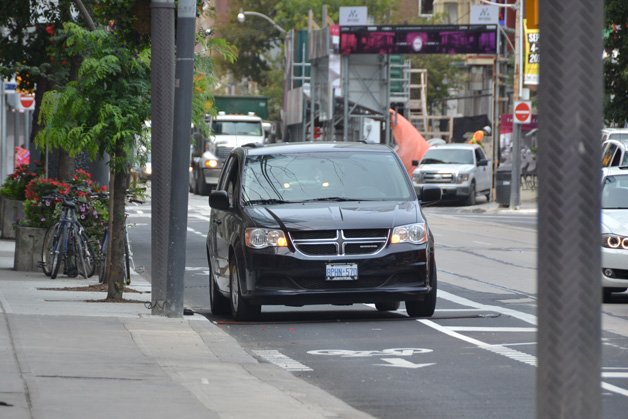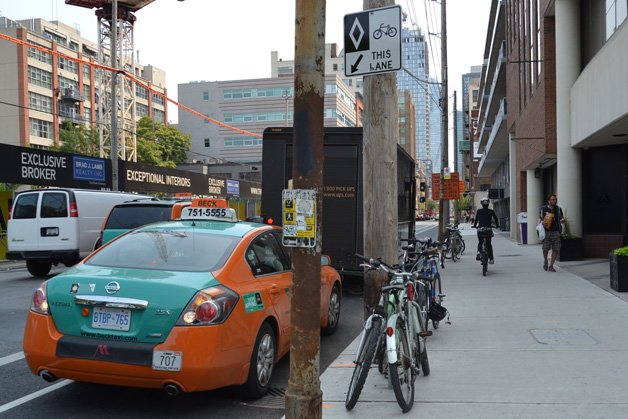
The pilot project of a physically separated bike lane on Adelaide was only launched last week, but even a quick stroll down the street provides ample evidence that, at least in its current configuration, it’s not working.
For starters, it’s not actually a physically separated bike lane.
Although the staff report approved unanimously by council in June noted that the best configuration on Adelaide would be a “cycle track separated… by a painted buffer and flexi-posts,” only the painted buffer materialized. The flexi-posts were left out, and drivers are routinely encroaching on the lane.
In an interview with the Toronto Star on Wednesday, General Manager of Transportation Services Stephen Buckley defended the project, saying that he had only seen one or two drivers in the bike lane when he has visited the street.
I suspected Buckley’s count might be a little low, so I went down to Adelaide to see for myself. I walked the entire length of the lane, from Simcoe to Bathurst, and back again. In 45 minutes, I counted 27 motor vehicles in the bike lane, nine of them actually driving in it.
Multiple taxis pulled into the lane to drop off or pick up fares, as did two UPS trucks and a Canada Post vehicle that were making deliveries. Some drivers simply became impatient waiting behind a line of stopped cars and pulled into the bike lane to bypass them. The signs warning of a $150 fine for stopping in the bikeway appeared to be no deterrent.
After I made it back to Simcoe, I stood just west of the intersection and watched as a truck drove through the bike track in order to make a right turn.
I showed the video to Councillor Denzil Minnan-Wong, chair of the Public Works and Infrastructure Committee, and he agreed it was a cause for concern.
“I’m not pleased about that at all,” he said. “That’s someone who is not following the rules, notwithstanding that we have more significant and higher fines.”
He pointed out that two years ago council voted to raise the fine for encroaching on a bike lane from $60 to $150, and said that for the lanes to work traffic services needs to enforce the rules. He said it was too early to determine how well the Adelaide project is going, however.
“This is a pilot project to see what works and what doesn’t work on the street,” he said. “If the current solution doesn’t work and can’t be enforced, then we’ll have to look at other remedies.”
In an interview Buckley told me that the project is still evolving and that new elements, including bollards or barrels could be added later. He didn’t dispute reports of multiple cars using the bike lane, but maintained that in his 10 or 12 visits to the site he’s seen “no more than two encroachments.” He said city staff are monitoring the lanes for violations but he hasn’t yet seen the data they’ve collected.
Like Minnan-Wong, Buckley believes that enforcement of existing rules would go a long way to making Adelaide a success. To that end he wrote to the Canadian Courier and Logistics Association, as well as representatives of taxi drivers, and asked them to stay out of the bike lane.
“We told them about the new facilities, we asked them to ask their membership to be respectful of them, and we’ve warned them about the new fines.”
“We do believe that they have gotten better about illegal parking,” he said, while conceding as of yet there’s no empirical evidence to support that belief.
Councillor Mike Layton, who sits on the Public Works Committee, says it’s clear the painted buffer design is a failure. He wants the transportation department to put in a physical barrier of some kind soon, whether it be bollards (like those used around the corner on Simcoe) or planters (like those used on John.)
“Obviously it wasn’t very effective if people are driving in the lane and parking in the lane pretty consistently,” he said. “Clearly this approach, just the painted line approach, isn’t one that works.”
Jared Kolb, executive director of Cycle Toronto, agrees. He argues that transportation services had no authority to install a painted buffer because council explicitly approved a trial of separated lanes. He says it doesn’t make sense to test a lane that isn’t physically separated and instead, the city should use the pilot to test out different kinds of barriers.
“There’s no need to experiment with just paint. We’ve been doing that for the last 15 years here in the city, we know it’s a failed exercise,” he said.
The Adelaide lane is the first phase of a pilot project that will also see a bikeway installed on Richmond. The Richmond lane will also be a painted buffer, although Buckley said that might change because there are some spots where he expects paint won’t be enough to keep drivers out.
“Out of the gate, there will likely be ongoing issues with violations,” he said.
The pilot on both streets will last until next year, at which time council will decide whether to install permanent bikeways in the corridor.
The council-approved budget for the Richmond-Adelaide cycle track pilot project is $390,000, a cost that includes permanent bike infrastructure on connecting streets. The Adelaide lane was budgeted at about $200,000.
bens@nowtoronto.com | @BenSpurr
















